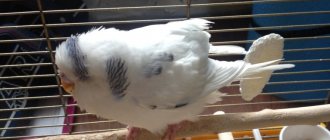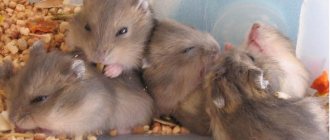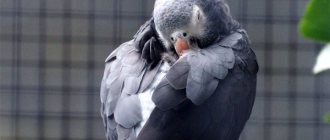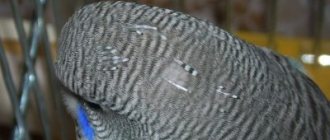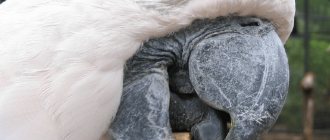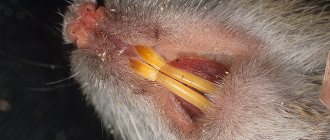A healthy bird has a perky disposition, sparkles of joy appear in its eyes, and its movements are light and playful. The appearance of tremors in the body causes illness, improper feeding, exhaustion, and weakening. Often the situation can be resolved on your own. If the pet does not respond to contact, does not go for a walk, but sits in one place with its wings ruffled, it needs specialized treatment from a veterinarian and special care.
Stress
Parrots have a highly developed nervous system and they react very vividly to any changes in the environment. The behavior of a newly purchased pet placed in an unfamiliar environment will indicate how easily it adapts to change. If your parrot's tail is shaking or its wing is trembling, it may take some effort to get it comfortable in its new habitat.
It may take about two weeks for your parrot to adapt. During this period, try not to annoy your pet; too intrusive attention can stress him out.
Some useful tips:
- Place the cage at eye level. If you look at your parrot from above, it will feel depressed.
- The cage must always have fresh water and high-quality fortified food.
- Do not allow children to make noise and scream near the cage or pester the parrot.
- Keep other pets away from the cage as they may frighten the bird.
- Accustom your pet to you gradually. Cover yourself with a blanket along with the cage, try to take the parrot in your hands and talk to him affectionately.
If the bird's condition does not improve after 2 weeks, try to identify possible other reasons why the parrot is trembling.
Main reasons
Stress
The most common cause of trembling in a cockatiel, budgerigar or other bird species is stress. It can be caused by a change of environment, new people or objects in the cage. The bird can also be frightened by children, animals, loud noises, and bright lights.
One of the main reasons for shaking in a parrot is stress.
Diseases
Many illnesses that cause your pet to be exhausted, fever, chills or severe pain can be manifested by trembling. At the first signs of ill health, your little friend must be shown to an ornithologist to establish a diagnosis and begin treatment as soon as possible.
Infections
Often diseases of parrots are infectious in nature. In this case, the use of antibacterial and antiviral drugs will be required, which must be prescribed by a veterinarian.
First flights
If a young parrot's wings are trembling, it may soon attempt to fly. Your parakeet should be allowed to fly indoors for two hours a day. He must fly under supervision in a safe environment. It is necessary to remove traumatic objects and avoid contact with other pets: rats, dogs, cats.
A lack of calcium can negatively affect a bird's ability to fly. Place mineral stones and sepia, cuttlefish shell in the cage.
First aid
Before deciding what to do to help the bird, it is necessary to determine the exact cause of the trembling. If the parrot is ruffled and trembling from the cold, it should be warmed up; At the same time, it is important to prevent overheating, which is also harmful to the health of the bird. If the trembling is caused by fear or stress, you need to move the cage to a quiet room, talk to your pet in a calm voice and treat him with a treat.
If the cause of trembling is improper feeding, you should change the bird's diet, introduce soft and succulent food and vitamin supplements. If there are any signs of disease (infection, parasite damage, injury, etc.), the parrot must be shown to a veterinarian as soon as possible. Incorrect or untimely treatment can lead to deterioration and death of the pet.
Disease
The sight of a ruffled, trembling parrot may indicate the development of a serious illness. The following accompanying signs should alert you:
- Changes in the color, smell and consistency of droppings;
- lack of appetite;
- dyspnea;
- apathy;
- excessive loss of feathers.
Parrots kept at home can suffer from infectious diseases. They are susceptible to gastrointestinal diseases, bronchitis is common; what to do if the parrot is trembling and dangerous symptoms are detected? It is necessary to urgently consult a specialist for advice.
If for some reason this cannot be done, follow the recommendations that will help alleviate your pet’s condition.
- Keep your parrot warm. Cover half of the cage with a towel, and above the other half place a lamp with an incandescent lamp of 40 - 60 W at a height of 30 cm. The parrot will bask under the lamp, and if it gets hot, it will move to the covered part of the cage. The lamp is turned on for 20–30 minutes during the day every 3 hours. Important! Do not use a fluorescent lamp; its flickering will irritate and unnerve the bird.
- If there are signs of poisoning (loose stools, vomiting), be sure to give your parrot a sorbent, enterosgel or activated carbon. It is diluted with water and injected using a syringe without a needle into the slit near the beak, 3 to 4 drops several times a day. Pour chamomile infusion diluted with water (1:1) into the drinking bowl and change it often during the day; Fill the drinking bowl with clean water at night.
Don't ignore your trembling parrot. If you don't take action in time, you may lose your pet.
Why is he shaking his head?
Your pet may shake their head for many reasons:
- Looking for someone.
- Be sick.
- Particles of grains remained in the crop.
- Presence of a tracheal mite.
To exclude these diseases, it is necessary to conduct a visual inspection for damage and palpate the bird’s body: wings, legs, torso. A healthy individual shakes its head for reasons of anxiety, fear or curiosity. The inflammatory process may be accompanied by nausea and diarrhea.
The grains are stuck in the crop
Cockatiels and budgies should not be fed large, unmilled grains. If swallowed, the bird may not completely separate them, which will cause pain in the crop. The stuck piece can be felt with light movements. Ignoring the symptom leads to the death of the pet. Trembling in the body is sometimes accompanied by food coming out of the beak, which can occur in case of overeating.
Presence of a tracheal mite
The tracheal mite is a parasite that lives in the upper respiratory tract of birds and feeds on the contents of the secretion, affecting the respiratory system: trachea, larynx. As the mite grows, it limits access to oxygen. When trying to breathe, the cockatiel begins to shake its head from side to side.
It is necessary to take a smear for parasites and analyze the droppings. After receiving the result, the doctor prescribes antiparasitic drugs if necessary. The treatment process lasts 2 weeks. The first symptoms of the onset of the disease are wheezing, coughing and slight loss of voice. The symptom of trembling can also cause other parasitic diseases that appear against the background of vitamin deficiency.
If your pet continues to tremble for 24 hours, you should take your cockatiel to the veterinarian.
Nausea
Nausea and tremors in birds appear due to poor nutrition, failure to observe meal times, the presence of difficult-to-digest food components, scarcity of vitamins in the feed, and monotony of the diet. If the symptom is not cured in time, then gradually the movements become slow, the bird is passive, apathetic to everything, the pet often shakes its head, trying to get rid of the unpleasant symptom on its own.
Nausea can be the cause of poisoning, symptoms of parasitic diseases, skull trauma, and pathological processes of the digestive system. In such cases, the cockatiel needs care and a special treatment method.
Tumor of the swallowing organs
The tumor is a rare disease of birds, which during the growth process blocks access to air. During life, malignant cancer releases toxic substances into the blood, and during decay, toxic compounds that cause inflammatory processes, increased body temperature, which results in chills. Small tumor-like growths interfere with the development of vocal melody, and the individual begins to shake its head.
The process manifests itself in the form of symptoms: body trembling, difficulty swallowing, tickling.
A tumor of the respiratory organs is caused by inflammatory processes. In this case, it is necessary to apply dry heat to the sore spot and give the bird only warm water to drink. If the procedures are performed frequently, the swelling will be relieved quickly. Impaired swallowing is a dangerous symptom; if it is not eliminated, the pet will die from suffocation.
Injury
If the parrot has suffered a spinal injury, where the nervous system is involved, the initial symptoms will appear in the form of head twitching. If the parrot experiences pain, then it is necessary to find out where the damage occurred.
Dangerous symptoms that may accompany a parrot with chills
The parrot's trembling, lethargy and closed eyes may indicate not only its hypothermia. If the cause is illness, then other symptoms will appear within 3 days. It is important to identify them as early as possible.
Clear signs of dangerous diseases:
- a bent leg tucked under the body or a drooping wing indicates dislocations and fractures;
- small purulent or bleeding wounds on the body - may indicate various skin diseases;
- digestive disorders: diarrhea, constipation, vomiting;
- lack of appetite, sleepiness, immobility indicate colds or poisoning;
- baldness with itching and redness of the skin indicates the presence of parasites in the bird;
- trembling with convulsions, loss of appetite, hoarseness, uncharacteristic sounds that the pet makes - this is a cold or goiter.
On a note! If the parrot is crested and trembling, or other dangerous symptoms appear, it is necessary to conduct an examination at a veterinary clinic.
Contaminated air
Parrots have a special respiratory system, which includes several air sacs. During flight, these bags control body temperature, prevent overheating, and also enrich all internal systems and organs with oxygen several times better than in mammals.
This breathing system is very sensitive to various impurities in the air. Toxic particles and strong odors can be fatal, so it is necessary to ensure that perfumes, household aerosols, tobacco smoke, and air fresheners are not sprayed near the cage. During renovations in an apartment using varnishes and paints, glue, and other substances with a strong odor, the parrot should be left with relatives or friends. Toxin poisoning is difficult to treat, as it has a detrimental effect on the central nervous system and respiratory organs.
How to prevent your feathered pet's condition from getting worse
For a long and healthy life of a parrot, it is important to comply with all the conditions of its maintenance. It is important to carefully monitor his behavior and the slightest deviations from the norm. If a parrot raises its feathers, puffs itself up, has its eyes closed, and hides its head under its wing, this is hypothermia.
Temperature is an important factor for the health of a pet parrot. Variegated birds naturally live in hot countries. Warmth is their natural habitat. But they also do not tolerate heat well. The optimal comfortable temperature should range from +22…+25 C°. It is allowed to drop to +18 Cᵒ, but no more than an hour. This temperature is not comfortable for heat-loving birds and can cause the development of colds.
Higher temperatures and dry air provoke the appearance of skin diseases. This may be itching, loss of feathers, dry mucous membranes. As a result, the parrot begins to lose appetite and may get sick.
Chills and ruffled feathers are not symptoms of serious illness. Heating and a calm environment in the house will quickly relieve your pet from discomfort. If all the conditions are met, and the bird only gets worse, it is important not to ignore other symptoms. If the disease is detected at an early stage, it responds well to treatment.
Prevention
To eliminate unpleasant symptoms from your pet’s life, it is necessary to create acceptable feeding and maintenance conditions:
- Include fruits and vegetables in your diet. Feed regularly with food fortified with vitamins. Food and drink must be freely available. Check expiration dates on food regularly. Do not allow moldy products to be consumed.
- Artificially adjust daylight hours, giving the opportunity to fully rest.
- Avoid hypothermia and overheating.
- Do not create conditions for stress.
- Do not leave poisonous indoor plants, medications and small objects in the public domain.
If you follow the rules of care and take proper care, a budgie can live up to 15 years. A truly careful owner can extend its lifespan to 18 years. After all, only careful treatment of your pet keeps it active for a long time.
What to do if your parrot is shaking
- Stress . A budgie may tremble if it is nervous or afraid. Excitement may be due to a move or a change of owner. At first, it is necessary to disturb the bird as little as possible. Adaptation usually takes about a week. During this time, the parrot will get used to the new place and get used to the voice and presence of the new owner.
- Stressful situations often arise due to the presence of other pets. To ensure that your budgerigar does not experience fear and feels safe, it is necessary to limit access to the cage to other animals. It is always worth remembering that stress significantly reduces life expectancy.
- Also, the parrot's anxiety can be caused by the presence of children in the room where the parrot's cage is located. If the owner notices that the parrot is trembling, it is necessary to leave it alone. Over time, he will get used to the environment and new sounds and will stop being afraid.
- If your parrot is shivering due to hypothermia , you need to warm it up as soon as possible. You can place a special lamp next to the cage and point it towards the cage. The distance between the lamp and the cage should not be less than half a meter. The cage must be covered with fabric on two or three sides.
- A budgie may also suffer from overheating . The cage should not be placed next to heating devices, under an air conditioner, and the cage should not be exposed to direct sunlight. The optimal temperature for keeping budgies is 22-25 degrees.
- Often the reason that a parrot is trembling is due to improper or poor nutrition. A lack of vitamins in the body leads to the body weakening and being susceptible to disease. In addition to the grain mixture, the diet of a budgie should include vegetables and fruits, berries, herbs, tree branches, cereals, and mineral supplements. If your parrot refuses any food, you can purchase liquid vitamins that can be added to the water.
- of illness are noticed (vomiting, heavy breathing, discharge, unkempt appearance), you should urgently consult a specialist. He will order tests, determine the disease and severity.
- For various injuries and damage, the parrot should be carefully placed in a carrier and shown to a specialist.
If your budgerigar has been trembling for a long time, and the reason cannot be found out, you should seek help from a breeder or an ornithologist. The parrot should not be allowed to remain in this state for a long time. It is important to find out the cause of this behavior as early as possible and eliminate it.
Avitaminosis
The parrot is shaking due to a lack of vitamins. You should consult your veterinarian about this. Perhaps changing the food to one enriched with microelements will help. After consultation, a vitamin supplement is chosen for the main diet. Feeding with fresh vegetables and fruits cannot be ignored. Almost everything suits parrots except papaya, persimmons and nuts. It is also necessary to offer the bird greens:
- sorrel;
- dandelions;
- wheatgrass;
- shepherd's bag
The main thing is to find out in time why the parrot begins to shake.
Adaptation of a bird to a new home
When changing a cage or moving to a new home, a parrot may feel not just discomfort, but even severe stress. You will notice that he is cackling and shaking, but you will not understand why. If you have recently moved or bought a new cage, then you will just need to wait until the bird gets used to it, carefully examining its home with its eyes.
Sorry, there are no surveys available at this time.
Talk to him, monitor his behavior and do not let him out for several days. Let the baby get used to the new home, look around, notice all the toys. It happens that the bird gets ruffled and looks irritated and constantly angrily rushes at some object. To calm your pet, simply remove the irritant from the cage.
Goiter inflammation
This is a disease of granivorous birds, often occurring with vague symptoms. The main symptom is inflammation of the goiter sac. In addition, the bird:
- shakes and stretches his neck;
- behaves restlessly;
- constantly regurgitates food;
- becomes lethargic;
- refuses food.
In advanced cases, the parrot spits out food, the mucous membranes become bluish, and the crop sags. The pet cannot swallow at all, its beak often opens, viscous saliva appears, and the feathers on its head stick together. The bird subsequently dies. This condition leads to:
- poor quality food;
- poisoning from toxic plants or chemical vapors;
- complication after infectious diseases.
It happens that a bird does not receive the necessary mineral elements and compensates for them by stuffing its crop with grain, which leads to inflammation.
The disease is often detected at a stage when it is practically impossible to help the pet. As a rule, treatment at home cannot save the bird; an urgent visit to the veterinarian is necessary. It is important not to miss the symptoms and find out why your pet parrot's head begins to shake.
For this purpose, an examination is carried out. Antibiotics are used only if the infectious origin of the disease is confirmed. In parallel with the main treatment, medications are given to support the liver. To avoid exhaustion, the bird is fed liquid porridge.
Tracheal mite
This avian parasite causes a disease called sternostomosis. This disease affects the internal organs, larynx and trachea. Due to difficulties with swallowing and breathing, the parrot begins to actively shake its head and may even spit out grains. You can understand why a parrot shakes its body if you track other symptoms. At first, there is a partial loss of voice, coughing, and wheezing.
To accurately diagnose the disease, it is necessary to take a tracheal smear to check for parasites. A litter analysis is also needed. If the test shows the presence of mites, the veterinarian will prescribe treatment.
Important! The dosage of medications, the treatment itself and its duration are determined only by a specialist.
The prescribed medications are taken for about 2 weeks.
